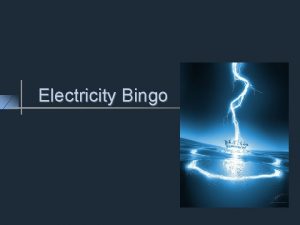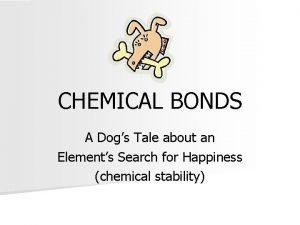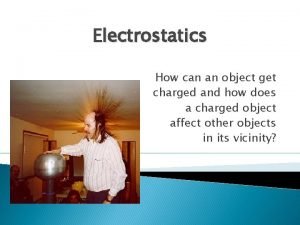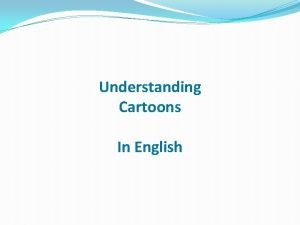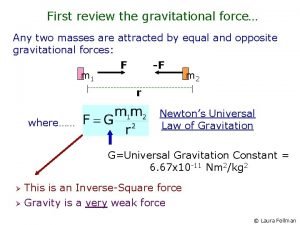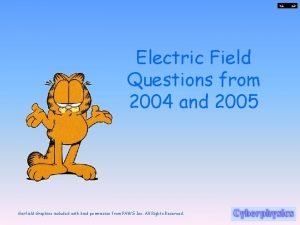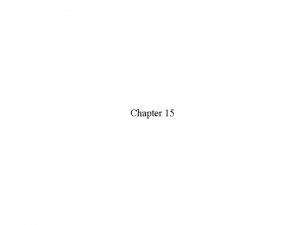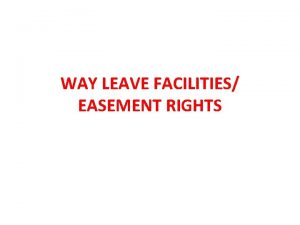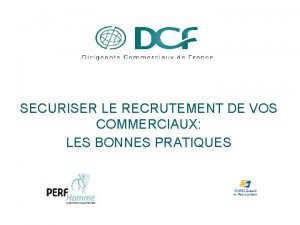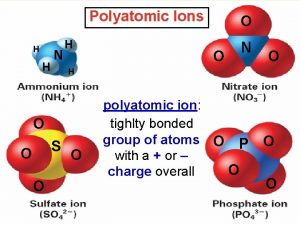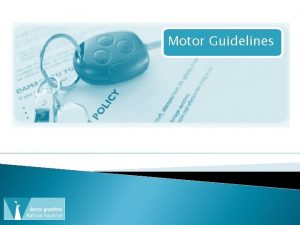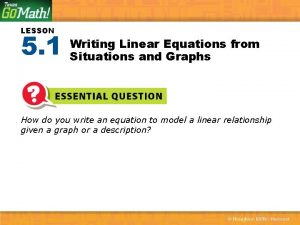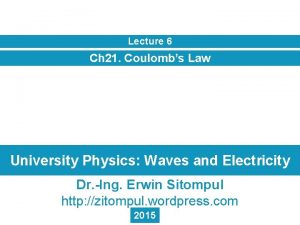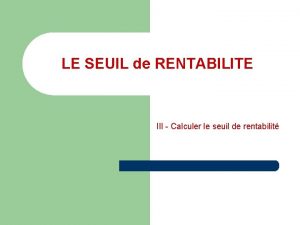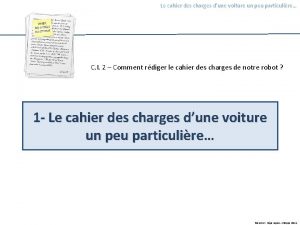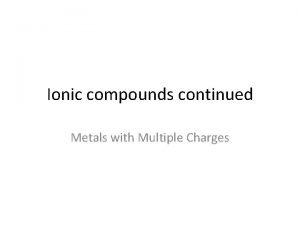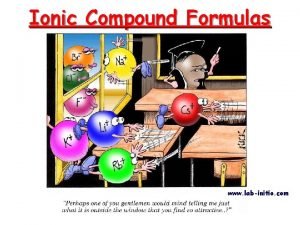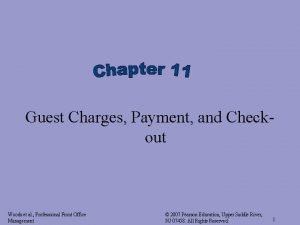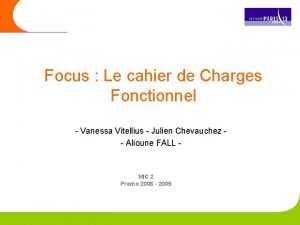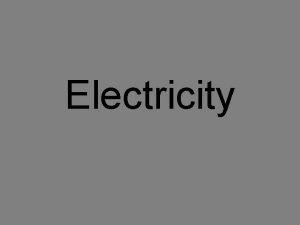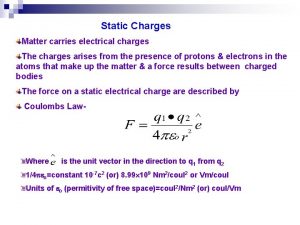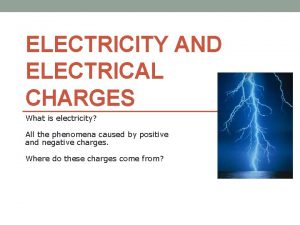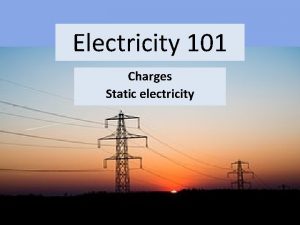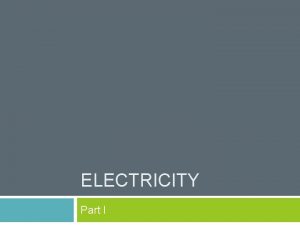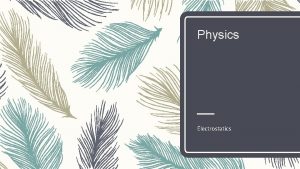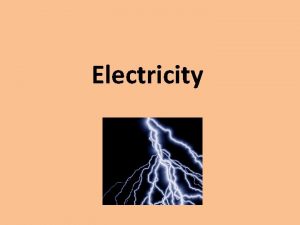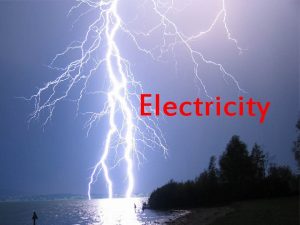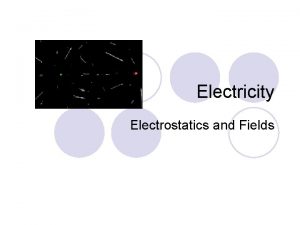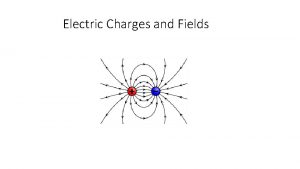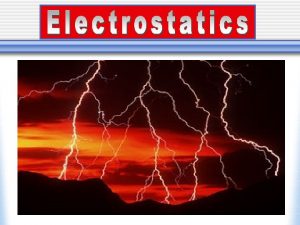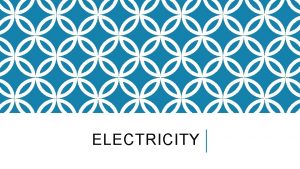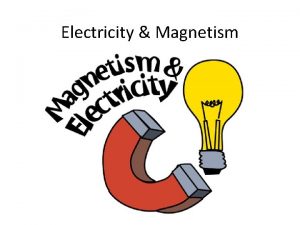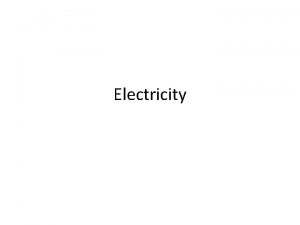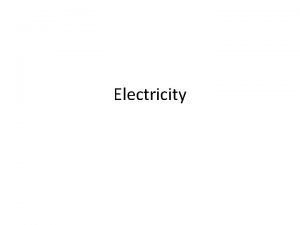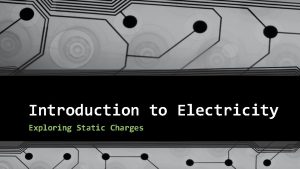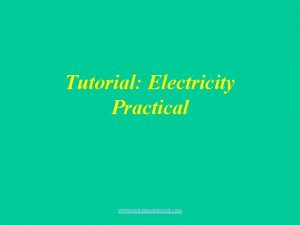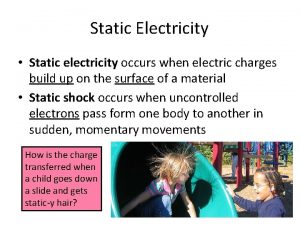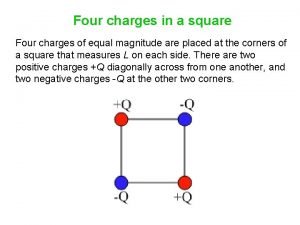Electricity Electricity and Electrical Charges What is electricity






























- Slides: 30

Electricity

Electricity and Electrical Charges What is electricity? All the phenomena caused by positive and negative charges. Where do these charges come from?

Nucleus: ¡ ¡ ¡ Contains protons (+) & neutrons (no charge) Overall positive charge (+) Provides the biggest mass contribution (dense) Electrons: ¡ ¡ ¡ Located outside nucleus Easily moved, lost or gained Negative charge (-)

Electrical Charges: ¡ All matter has electrical charges ¡ There are two types of charges: l Positive l Negative + -

Negatively charged objects: contain more electrons (-) than protons (+). Positively charged objects: contain fewer electrons (-) than protons (+). Only negatively charged electrons can move from one object to another and if you have an equal number of protons and electrons, the object is neutral.

Ch 5. Electricity & Magnetism Wr ite 5. 1 Electrical Charge t no his ote i bo n yo ur ok. Most objects are neutral because they have an equal # of protons (+) and electrons (-). ¡ Electrons can be transferred, this causes an object to become charged. ¡ l l Negative charge = object has more electrons than protons. Positive charge = object has more protons than electrons.

¡ There are 2 forces between charged objects: Attraction Repulsion ¡ Opposite charges ¡ Same charges ¡ “Opposites Attract” ¡ “Like repel”

Sphere A is negatively charged. When placed beside sphere B, they attract. What is the charge on B? POSITIVE AA - B + Opposites Attract!

Three charged spheres are suspended next to each other. If sphere A is negatively charged, what will happen when sphere A & C are suspended beside each other? Attract A B B C A C

Four charged spheres are suspended next to each other. What will happen if A & D were suspended next to each other? Repel A B B C + + + - C D - +

You have three charged objects A, B & C in a lab. You record the following result Test Observation Bring “A” near “B” They repel Bring “A” near “C” They attract + + + - What would happen if “B” & “C” were brought together? They would attract!!!

Worksheet ¡ Write answers onto spare paper.

Charging Objects ¡ Most objects start out electrically neutral, but by CHARGING an object you create an imbalance in the number of electrons and protons; the object is then charged either positive or negative.

How do you charge an object? ¡ There are three ways to charge an object: 1. Charge by Friction 2. Charge by Conduction 3. Charge by Induction

Charging by Friction ¡ When two neutral objects are rubbed against each other, one object may pull electrons away from the other creating one positive object and one negative object.

Triboelectric Series: ¡ ¡ ¡ All objects begin neutral & can become positively or negatively charged A positively charged object has more positives than negatives A negatively charged object has more negatives than positives

Only negative charges move! Triboelectric Series: Positive charges NEVER move!! ¡ Triboelectric series is a list that ranks objects’ ability to take negative charges Rubber Ebonite Polyethylene Cotton Paper Silk Items at top take electrons (-) Write this i noteb n your ook. Wool Glass Acetate Fur / hair Items at bottom lose electrons (-)

Items at top take negatives Your cat rubs against a rubber balloon. What will be the charge on the balloon? Your cat’s fur? Rubber balloon Ebonite becomes Polyethylene negative Cotton Silk Wool Glass Acetate Fur / / Hair Fur Hair Negatives Cat’s fur becomes positive

Items at top take negatives In a lab, you take a piece of neutral wool & neutral polyethylene & rub them together. What will be their charges? Rubber Ebonite Polyethylene Cotton Silk Negatives Wool Glass Acetate Fur / Hair Polyethylene balloon becomes negative Wool becomes positive

In a lab, you rub a piece of cotton & ebonite together. Then you rub a piece of silk & glass together. You then bring the charged piece of cotton & the charged piece of silk together. What will happen? + + Rubber Ebonite Polyethylene Cotton Silk Wool Glass Acetate Fur / Hair Cotton is + Silk is - They would ATTRACT

You rub your hair with a balloon. Explain using words & pictures, why your hair “sticks up”. 1 st The hair & balloon are both neutral 2 nd The rubber balloon takes negative charges from the hair. So, the balloon becomes negatively charged & the hair becomes ++_ _ positively charged 3 rd Since the hair is positive & like charges repel, the hair sticks up!!! _ +_ _ + +

Check for understanding Using pages 140 to 144 and your notes. ¡ Fill-in p 75 & 76 of your workbook. ¡ l If you don’t finish in class it is homework.

5. 2 Static electricity. W ri t et no his te bo in y ok ou r. ¡ You can create a charge by causing electrons to be transferred from one item to another by: l l l Friction. Items high on the triboelectric series pull electrons away from lower items. Conduction. Once in contact, a charged object can share its charge with another neutral object. Induction. Without contact! A charged object can cause the charges in a neutral object to shift to one side. ¡ See p 147

Charging by Conduction ¡ An object can be charged by touching it with another object that already has a charge. The resulting object will then have the same charge but weaker in strength than the original object.

Charging by induction objects do not touch (one is charged, one is neutral) ¡ Proximity of the charged object causes (induces) the charges in the neutral object to separate. ¡ See Fig. 5. 17 in textbook. ¡

Write this in your notebook. Calculations: How do you measure “charge” ¡ The unit of measure for electrical charge is the Coulomb (C). In equations it is symbolized by a “q” l Eg: q = 900 C ¡ Ex. After charging a piece of fabric Kim determines that it has a charge of 9. 1 C. How many electrons has it lost?

(5. 1 continued) ¡ ¡ ¡ Write this i noteb n your ook. One electron has a charge of 1. 602 x 10 -19 C. 1 Coulomb (C) = the charge of 6. 25 x 1018 electrons (-) or protons (+). Conductors permit the movement of electrons. (the charge spreads out quickly) l Eg. Metals, graphite, electrolytic solutions Semiconductors slow their movement. Insulators stop their movement electrons. l Eg. Plastics, ceramics, wood, glass The triboelectric series (p 146) is a list that ranks an object’s ability to take negative charges.

Robert J. Van de Graaf 1929

Check for understanding Using pages 145 to 149 and your notes. ¡ Fill-in p 77 (bottom only) & p 78 (#1 & #2 only) ¡ l If you don’t finish in class it is homework.

These notes have covered: ¡ p 140 to p 148 in the text ¡ P 75 to p 78 in the workbook
 Like charges blank and opposite charges blank
Like charges blank and opposite charges blank Static electricity and current electricity
Static electricity and current electricity Static electricity and current electricity
Static electricity and current electricity How are static electricity and current electricity alike
How are static electricity and current electricity alike Partial bonds
Partial bonds Phet charges and charged objects investigation
Phet charges and charged objects investigation Interpretação de cartoons
Interpretação de cartoons Effect of gravitational force
Effect of gravitational force Electric charges and electric forces lesson outline
Electric charges and electric forces lesson outline Three subatomic particles and their charges
Three subatomic particles and their charges Two charges p and q are 100mm apart
Two charges p and q are 100mm apart Which of the charges qa, qb, and qc are positively charged?
Which of the charges qa, qb, and qc are positively charged? A caterer charges $120 to cater a party
A caterer charges $120 to cater a party Way leave facility
Way leave facility Cutting charge
Cutting charge Cahier des charges recrutement
Cahier des charges recrutement What is a polyatomic ion
What is a polyatomic ion Charges periodic table
Charges periodic table Gr idv
Gr idv Writing linear equations from situations and graphs
Writing linear equations from situations and graphs Three point charges are arranged along the x-axis
Three point charges are arranged along the x-axis Seuil de rentabilit
Seuil de rentabilit Cahier des charges voiture
Cahier des charges voiture What is land use certificate
What is land use certificate Multiple charge metals
Multiple charge metals Ionic charge of co3
Ionic charge of co3 Guest charges
Guest charges Late charges in front office
Late charges in front office Guest accounting cycle
Guest accounting cycle Def cahier des charges
Def cahier des charges Opposite charges attract.
Opposite charges attract.
